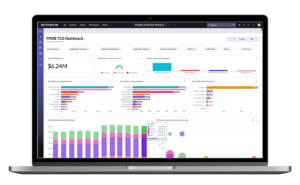Nobody knows if today’s current economic pullback will be a short-lived anomaly or a long-term struggle, although the odds are leaning toward the latter according to the Bloomberg Economics recession probability model — which forecasts a 100% chance of a recession within the next 12 months.
But regardless of when the next recession hits, how severe it is, and how long it sticks around, the actions required to survive and thrive remain the same.
Here are four rules every CIO and IT leader should follow to weather any recession.
Think Twice Before Pausing Digital Transformation Initiatives
When IT costs are under scrutiny and the business is searching for things to cut, the knee-jerk response is usually to sacrifice digital transformation first.
But as two experienced voices explain here, an economic downturn is the last time you should pump the brakes on digital transformation. Unless resources are genuinely unavailable — not just allocated elsewhere — new transformation projects shouldn’t be delayed, especially those that drive differentiation.
Steve Bates, global leader of KPMG’s CIO center of excellence, tells CIO.com:
“There is going to be pent-up demand when this period ends, and there is going to be a tidal wave of spending. You want to be in a position to take advantage of it.”
Rethink Your Workforce Assumptions
There are three bad workforce assumptions IT leaders often make during economic downturns. At first, they seem perfectly logical. But under closer scrutiny, they simply don’t hold up:
“We should cut positions and outsource wherever possible.”
Outsourcing has been a popular play in the IT cost-cutting playbook for years, and nobody can deny its utility for delivering short-term savings. That said, those short-term savings come with strings attached.
Outsourcing is transactional. It might be cheaper than paying an FTE, and the quality of work might be comparable. But all the knowledge and training you invest in outsourced positions disappear once the relationship is over.
The cost of keeping an FTE vs. outsourcing isn’t trivial, but neither is the value of their future skill and ability. Shouldering the cost to keep key talent internal is worth it more often than not.
“Keeping good employees is easy in a recession.”
In a struggling economy, employees who don’t lose their jobs are less likely to quit by choice, right? That’s only true for some employees. And unfortunately, those employees aren’t necessarily the ones you want to keep.
Most often, the employees who cling to their positions during a downturn are usually the ones least able to find another position — i.e. the least skilled and valuable. Meanwhile, top performers are always more likely to seek greener pastures, and a downturn gives them one more reason to leave if/when they find something better.
IT consultant and BYU professor Bruce Webster calls this the “Dead Sea effect,” since it leads to your best employees ‘evaporating’ and leaving behind the ‘residue’ of bottom performers.
“We should avoid new hires until things bounce back.”
When the business is looking to aggressively reduce costs, the idea of bringing on new people probably sounds crazy. But there’s a good argument to be made for hiring during a downturn — if done cautiously and strategically.
Star players are often easier to snag during a recession, especially during the onset and early stages. Not only will more of them be searching the job market; their expectations will be much different than they were pre-recession.
Cultivate a Close Relationship With Your CFO
As we’ve discussed before, having a strong CFO relationship is critical for any CIO’s success, and it becomes even more critical during an economic slowdown. Without the CFO’s support, IT will always be playing defense in budget conversations — even more so when there’s extra financial pressure.
How do you win over your CFO?
The first and biggest step is to provide a clear, detailed explanation of all technology costs and the value those costs deliver. Granted, that’s easier said than done, but it’s really the crux of the issue.
Give Staff Clear, Consistent Updates
Responding to a recession is stressful and nerve-wracking for any business leader. But it’s just as bad — in some ways likely worse — for your employees. They need and deserve insight on where the business is headed, and it’s your job to supply it.
Stan Lowe, CISO for cloud security vendor Zscaler tells CIO.com:
“Your employees are more worried than you are because they don’t have access to the planning information, which could cause serious morale and production problems. At these high-level meetings, we forget that we know what we know, but they don’t know what we know so you can’t communicate often enough.”
Granted, you should still use discretion in terms of what you share and when; divulging every detail the moment you hear it yourself is neither necessary or wise. What’s important is that you give employees an accurate picture of what’s happening — within a reasonable timeframe and as objectively as possible.
Optimize Costs, Then Optimize Demand
Overall interest in cost optimization initiatives was already growing at the beginning of 2020, and it’s sure to grow even faster now, given the current economic climate — and especially as organizations realize the consequences of blind, across-the-board cost cuts.
That said, if you aren’t pursuing some form of cost optimization already, now is a wise time to start, even if you make it a slow, incremental effort. And once you’ve achieved an acceptable baseline for supply-side IT cost efficiency, the next step is to start optimizing demand — leading to an environment where IT provides services at the lowest expense possible and business users consume only what they need, nothing more and nothing less.
To learn how Nicus can help you optimize both costs and demand, reach out to start the conversation today.





